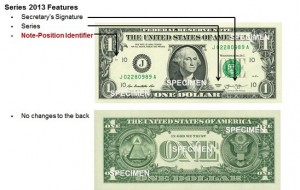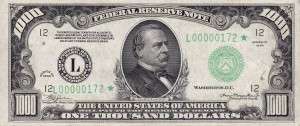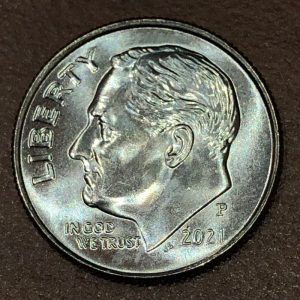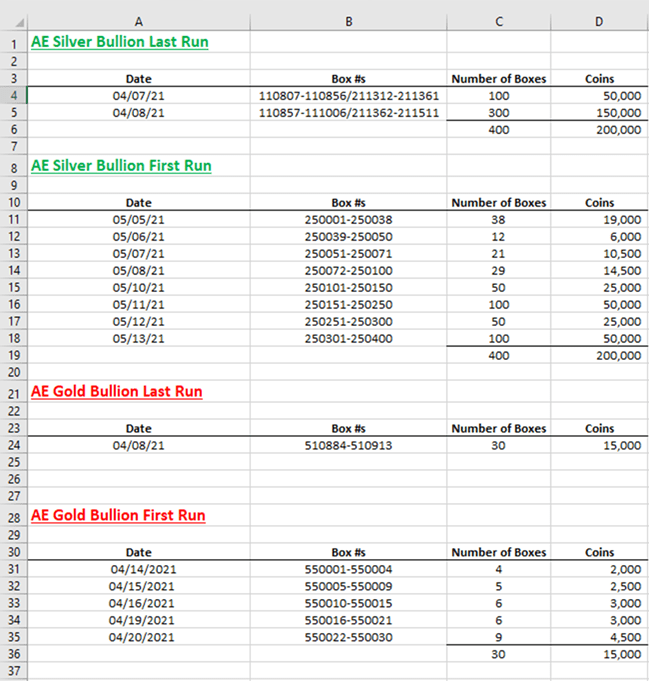What about eliminating the $1 Federal Reserve Note
For most of the 21st century, many groups have advocated for eliminating the $1 bill, while others provide a counterpoint to maintain the status quo. While the discussion of eliminating the note has economic and policy concerns that lawmakers must address, how would the U.S. government implement the policy?
The Federal Reserve Act of 1918 gives the Federal Reserve the authority to procure, distribute, and manage the nation’s currency supply. They must procure the paper money from the Treasury Department, but the Federal Reserve is required to tell Treasury how much money they need to print. But does the Fed determine which notes to print?
The law (12 U.S. Code § 418) says that the Treasury Department prints notes in “the denominations of $1, $2, $5, $10, $20, $50, $100, $500, $1,000, $5,000, $10,000 as may be required to supply the Federal Reserve banks.” The statement suggests that the Federal Reserve banks set the printing requirements. Does this mean that the Federal Reserve banks can tell Treasury that it no longer requires them to print the $1 note?
Neither entity can make this decision alone. On July 14, 1969, history teaches us that the Treasury Department and the Federal Reserve announced they would discontinue issuing $500 and higher notes “immediately due to lack of use.” Even though the Bureau of Engraving and Printing last printed these notes in 1945, the Nixon Administration felt that removing them from circulation would help reduce crime. The Federal Reserve withdrew the notes as customers deposited them in banks.Although the denominations remain part of the law, the Federal Reserve Act gives the Federal Reserve latitude to manage the currency supply as it deems necessary. It was a policy enacted by the Treasury and Federal Reserve in tandem.
The agreement was not as easy as the history books want us to believe. In 1969, William McChesney “Bill” Martin was the Federal Reserve Chair. Martin was appointed by Harry S. Truman in 1951, fiercely guarded the Federal Reserve’s independence, and was known to push back against presidential policies with a minimalist approach to managing market factors. In the 1960s, Martin ran afoul of Lyndon Johnson and Richard Nixon for not doing more to help prevent a recession.
Following a meeting with Nixon in October 1969 about what his administration saw as an impending recession, Nixon announced that he would replace Martin when the Federal Reserve chair’s term expired on January 31, 1970.
It was not the first time the Federal Reserve changed United State currency without legislation. Since the formation of the Federal Reserve, the Federal Reserve authorized the printing of gold certificates, silver certificates, Legal Tender notes, Federal Reserve Banknotes, and the ongoing Federal Reserve Notes.
Before the formation of the Federal Reserve, the Treasury Department determined what currency to print and its design. Treasury Secretary Franklin MacVeagh proposed reducing the size of the currency paper in 1909. After years of study and discussion, Secretary Andrew Mellon approved new smaller designs issued in 1929. The change did not require new legislation.
Based on history, Treasury Secretary Janet Yellen and Chairman of the Federal Reserve Jerome Powell can decide to withdraw the $1 Federal Reserve Note from circulation. Powell can instruct the Federal Reserve Banks to stop issuing $1 bills and use the $1 coin instead. When the notes return to the Federal Reserve System, they can withdraw the notes and destroy them as they do with old currency.
Yellen can refuse by saying that she is following her boss’s policies, the President of the United States. But the Federal Reserve is an independent agency and does not have to ask for permission. By law, if the Federal Reserve does not order the printing of new $1 bills, the Bureau of Engraving and Printing will not print new currency.
Politics may prevent Yellen and Powell from making this decision, but they can do it and allow the United States to join the rest of the civilized world that no longer carries its unit currency in paper form.
COVID INFECTIONS AT THE WORLD’S FAIR OF MONEY
The following excerpt was part of an email sent by the ANA this afternoon:
If you feel ill or are displaying any COVID symptoms, consider quarantining for 10 days and/or getting a COVID test.
I have made my feelings known about the COVID-19 pandemic. It is the primary reason why I did not attend the World’s Fair of Money.
Every time I write about COVID-19, I receive at least a dozen emails filled with vitriol. The fact is that over 99-percent of those hospitalized with COVID-19 are not vaccinated, and 100-percent of those deaths are not vaccinated. Today, Alabama announced they have run out of ICU beds.
In the meantime, I hope that the ANA did the responsible thing and notified the appropriate people in Cook County, Illinois. They should make sure that the convention center workers are safe.
I will not attend a coin show regardless of the size until the pandemic subsides, including the Whitman Expo scheduled for November. I will deal with the short-term inconvenience for my long-term health.
Please stay healthy and safe.
Please get vaccinated!
POLL: Are you collecting 2021 coins?
U.S. numismatics collectors are different. On one side, there are the collectors of old coins. If the coin was not circulated and made of precious metals, then it is not worth collecting. They look at modern coins as “trinkets” or not worth their time. The rest of us will happily collect modern (post-1964) coins and the new issues by the U.S. Mint.
As an aside, my company sells sets of 50 State Quarters for higher prices than in 2019. Although there is an active market for this material, they sell for less than collectors paid in the 2000s.
Enough people are collecting modern material that the Treasury Inspector General has noticed the problems collectors have experienced with ordering from the U.S. Mint. Modern products are selling out as fast as they are offered, and premiums are rising 100-percent and higher on the secondary market.
For this poll, I am asking if you are collecting the coins produced by the U.S. Mint in 2021, then what are you collecting?
As always, your comments are welcome!
Are you collecting the new releases from the U.S. Mint?
Total Voters: 65
Inspector General to Investigate the U.S. Mint
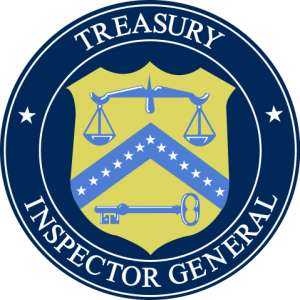 According to Coin World, the Treasury Office of Inspector General (OIG) “may” investigate how the U.S. Mint has handled the sales of limited-edition numismatic collectibles. Coin World may have confirmed information provided to me on background.
According to Coin World, the Treasury Office of Inspector General (OIG) “may” investigate how the U.S. Mint has handled the sales of limited-edition numismatic collectibles. Coin World may have confirmed information provided to me on background.
Although the web-based ordering has sort-of worked, I reported on the systemic issues facing the U.S. Mint in moving forward. In summary, my investigation found:
- The alleged silver shortage was not a shortage of silver but a failure of the U.S. Mint to manage its supply chain properly.
- The U.S Mint’s insistence that Internet robots (BOTs) were the cause of their web-based issues was the symptom of a more significant problem that they have not learned from their past mistakes.
- The U.S. Mint’s management managing like they were afraid of repercussions because the lawyers said so. The way it sounded, the U.S. Mint management was not managing but taking instructions. If they cannot manage, should they be replaced by lawyers?
An investigation by the Treasury OIG is an excellent first step. But experience has shown that an OIG report does not guarantee that U.S. Mint will fix the problems. I have seen government managers and appointees say all of the right things and do little to nothing.
It might require an act of Congress to fix the U.S. Mint. If it requires an act of Congress, don’t hold your breath waiting for changes.
How to Create A Price Guide
What does it take to create, publish, and maintain a price guide for coins?
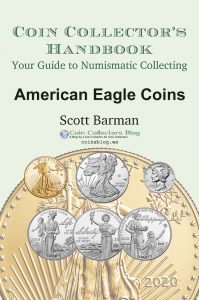 Readers who downloaded my first edition of the Coin Collectors Handbook: American Eagle Coins have asked about the lack of a price guide. I hesitated to add a price guide for American Eagle coins because, with very few exceptions, the spot price of metals affects the prices. Market watchers know that spot prices are volatile. Are there differences in prices that might make working on a price guide a good time investment?
Readers who downloaded my first edition of the Coin Collectors Handbook: American Eagle Coins have asked about the lack of a price guide. I hesitated to add a price guide for American Eagle coins because, with very few exceptions, the spot price of metals affects the prices. Market watchers know that spot prices are volatile. Are there differences in prices that might make working on a price guide a good time investment?
To better understand pricing and price guides, I asked several dealers what they use for pricing guidance. Most of them said the Greysheet and what the coins were selling on eBay. A few larger dealers will start their eBay auctions at $1 and sell the coins regardless of the final bid. High-volume dealers say they are rarely disappointed with the results.
Smaller dealers will subscribe to a service that will automatically adjust the prices based on the spot price and the results of the eBay inventory. Depending on the service level these dealers have with the service, the price for coins can change every day.
The pricing service can query eBay for list prices, and the prices realized to come up with their formula.
In the past, I tried to ask the people who write the Greysheet how they come up with prices. The harsh rejection at that time prevented me from asking again. It was time to look at other guides to determine how they create their prices.
Information from PCGS’s website is clear that their price guides are for coins only in their holders. In the past, PCGS noted their price guides use the prices on the Certified Coin Exchange market, which Collector’s Universe, PCGS’s parent company, owns.
Similarly, NGC notes on its website that they base their prices on the market of NGC-graded coins only. Neither service considered the market perception of CAC-certified coins. Although the Greysheet has a publication that publishes guidance for CAC-certified coins, that information is available only to subscribers.
One of the price guides not affiliated with a grading service is Numismedia. They are similar to Greysheet in that they offer a range of publications that span the market. Although their website does not disclose how they determine prices, their Fair Market Value guide has been more comprehensive and closer to retail market values than I have experienced with the Greysheet’s retail guides.
Other price guides found around the web have different concerns. A few are crowd-sourced, meaning that collectors provide input based on what they paid. Although crowd-sourced prices report real-world transactions, the information is limited to what users report and not a market survey.
Then there is the Red Book, A Guild Book of United States Coins. For 75 years, it has been the bible of coin values for many collectors. Unfortunately, the Red Book has several problems. First, it is published once a year and released in April. It means that production for the Red Book must begin before then.
A few years ago, I volunteered to work as a pricing contributor for the Red Book. I felt prices for modern coins were too low for the market, and I tried to bring them up to reality. It was challenging to make the edits using the poorly design web form. Even with my effort, much of my input did not make the book. The following year’s pricing entry was a spreadsheet, but my attempts at aligning the prices with the market did not affect the published prices.
Another problem with the Red Book is that the contributors are not given sufficient time to provide input. The process should be ongoing rather than giving the pricing editors a few weeks to edit the prices, so there is no rush before closing the edition.
Although I was not involved with the Blue Book (Handbook of United States Coins) pricing, I suspect it has similar issues.
It appears that every method used to create a price guide is flawed. Publicly accessible price guides are too generic to be taken seriously. Unless the public is willing to pay high prices for the wholesale guides, there is an opaqueness in how the industry prices coins.
Creating price guides is a difficult task. Over the next few weeks, I will continue my market survey while compiling the price guide for the American Eagles Handbook. I will share what I find here on the blog. Stay tuned!
Weekly World Numismatic News for August 15, 2021
Although this past week was the World’s Fair of Money, there was not much news surrounding the event. According to individual reports, people said that it was a good show even with the COVID precautions. It was similar to reports from The National, which was held in the Stephens Convention Center the week before.
The week’s biggest news was the U.S. Mint publishing the lot numbers used to label the boxes with the American Eagle bullion coins.
Until last year, the U.S. Mint has not identified where they strike the American Eagle bullion coins. Spokespeople emphasize that since their production is for the investment market, the mint location is not relevant. Of course, collectors view the market differently. Dealers and third-party grading services have tried to determine where the coins were struck based on shipping labels and other factors. Although they are reasonably sure, there are mistakes in their assumptions.
In 2020, the COVID-19 pandemic caused the West Point Mint to close temporarily. To keep up with production, the U.S. Mint struck 240,000 bullion coins in Philadelphia. The third-party grading services asked the U.S. Mint about the production of these coins. Rather than leave the industry guessing, the U.S. Mint identified which boxes contained American Silver Eagle bullion coins struck in Philadelphia. As a result, the third-party grading services accurately noted the origin of the bullion coin on the label of their slab.
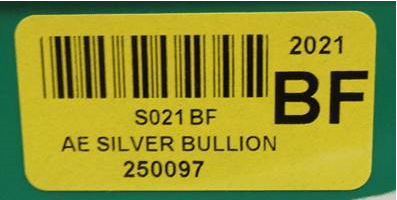
The U.S. Mint reports that some of the boxes marked with “BF” should not have the “F” since they were not part of the first production run.
Although the U.S. Mint has claimed it was always considerate to the collector community, it is the first time they voluntarily provided this information without prompting. Could the U.S. Mint finally be learning from past mistakes? Time will only tell.
And now the news…
 → Read more at smithsonianmag.com
→ Read more at smithsonianmag.com
 → Read more at dailymail.co.uk
→ Read more at dailymail.co.uk
 → Read more at israelhayom.com
→ Read more at israelhayom.com
 → Read more at ynetnews.com
→ Read more at ynetnews.com
 → Read more at tehrantimes.com
→ Read more at tehrantimes.com
